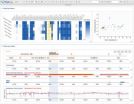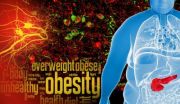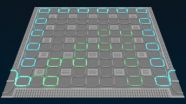(Press-News.org) Scientists at the University of Maryland have developed a new, web-based tool that enables researchers to quickly and easily visualize and compare large amounts of genomic information resulting from high-throughput sequencing experiments. The free tool, called Epiviz, was described in a paper published online on August 3, 2014 in the journal Nature Methods.
Next-generation sequencing has revolutionized functional genomics. These techniques are key to understanding the molecular mechanisms underlying cell function in healthy and diseased individuals and the development of diseases like cancer. Data from multiple experiments need to be integrated, but the growing number of data sets makes a thorough comparison and analysis of results challenging.
To visualize and browse entire genomes, graphical interfaces that display information from a database of genomic data—called "genome browsers"—were created. Epiviz offers a major advantage over browsers currently available: Epiviz seamlessly integrates with the open-source Bioconductor analysis software widely used by genomic scientists, through its Epivizr Bioconductor package.
"Prior tools limited visualization to presentation and dissemination, rather than a hybrid tool integrating interactive visualization with algorithmic analysis," says Héctor Corrada Bravo, assistant professor in computer science at UMD. He also has an appointment in the Center for Bioinformatics and Computational Biology of the university's Institute for Advanced Computer Studies.
Because Epiviz is based on the Bioconductor infrastructure, the tool supports many popular next-generation sequencing techniques, such as ChIP-seq, which is used to analyze protein interactions with DNA; RNA-seq, which reveals a comprehensive snapshot of the abundance of RNAs in cells; and DNA methylation analyses.
Epiviz implements multiple visualization methods for location-based data (such as genomic regions of interest) and feature-based data (such as gene expression), using interactive data visualization techniques not available in web-based genome browsers. For example, because display objects are mapped directly to data elements, Epiviz links data across different visualizations giving users visual insights of the spatial relationships of multiple data sets. The tool is designed to allow biomedical scientists to easily incorporate their own visualizations.
In the Nature Methods paper, Corrada Bravo, UMD computer science doctoral student Florin Chelaru, and undergraduate research assistants from Williams College in Mass. and Washington University in St. Louis used Epiviz to visualize and analyze DNA methylation and gene expression data in colon cancer. Changes in DNA methylation patterns compared with normal tissue have been associated with a large number of human malignancies.
Using Epiviz and Bioconductor, the research team found consistent regions of DNA methylation changes in colon cancer samples generated by the public Cancer Genome Atlas project and similar gene expression in these regions of DNA methylation changes in other cancer types. The results were in agreement with previous experiments, which were conducted by researchers at Johns Hopkins University in collaboration with Corrada Bravo, showing DNA methylation changes across large regions in the colon cancer genome.
"Epiviz helps biomedical scientists meet the challenge of visualizing large genomic data sets while supporting creative data analysis in a collaborative environment," says Corrada Bravo.
INFORMATION:
This research was supported by the National Institutes of Health (Award Nos. HG006102 and HG005220), Illumina Corp. and Genentech. The content of this article does not necessarily reflect the views of these organizations.
Héctor Corrada Bravo website: http://www.cbcb.umd.edu/~hcorrada/
The research paper, "Epiviz: interactive visual analytics for functional genomics data," Florin Chelaru, Llewellyn Smith, Naomi Goldstein and Héctor Corrada Bravo, was published online Aug. 3, 2014 in Nature Methods. http://dx.doi.org/10.1038/nmeth.3038
Media Relations Contact: Abby Robinson, 301-405-5845, abbyr@umd.edu
Writer:
Melissa Brachfeld
University of Maryland
College of Computer, Mathematical, and Natural Sciences
2300 Symons Hall
College Park, Md. 20742
http://www.cmns.umd.edu
About the College of Computer, Mathematical, and Natural Sciences
The College of Computer, Mathematical, and Natural Sciences at the University of Maryland educates more than 7,000 future scientific leaders in its undergraduate and graduate programs each year. The college's 10 departments and more than a dozen interdisciplinary research centers foster scientific discovery with annual sponsored research funding exceeding $150 million.
UMD researchers develop tool to better visualize, analyze human genomic data
2014-08-03
ELSE PRESS RELEASES FROM THIS DATE:
Making sense of scents
2014-08-03
For many animals, making sense of the clutter of sensory stimuli is often a matter or literal life or death.
Exactly how animals separate objects of interest, such as food sources or the scent of predators, from background information, however, remains largely unknown. Even the extent to which animals can make such distinctions, and how differences between scents might affect the process were largely a mystery – until now.
A new study, described in an August 3 paper in Nature Neuroscience, a team of researchers led by Venkatesh Murthy, Professor of Molecular and Cellular ...
Clues to curbing obesity found in neuronal 'sweet spot'
2014-08-02
New Haven, Conn. -- Preventing weight gain, obesity, and ultimately diabetes could be as simple as keeping a nuclear receptor from being activated in a small part of the brain, according to a new study by Yale School of Medicine researchers.
Published in the Aug. 1 issue of The Journal of Clinical Investigation (JCI), the study showed that when the researchers blocked the effects of the nuclear receptor PPARgamma in a small number of brain cells in mice, the animals ate less and became resistant to a high-fat diet.
“These animals ate fat and sugar, and did not gain ...
Pepper and halt: Spicy chemical may inhibit gut tumors
2014-08-02
Researchers at the University of California, San Diego School of Medicine report that dietary capsaicin – the active ingredient in chili peppers – produces chronic activation of a receptor on cells lining the intestines of mice, triggering a reaction that ultimately reduces the risk of colorectal tumors.
The findings are published in the August 1, 2014 issue of The Journal of Clinical Investigation.
The receptor or ion channel, called TRPV1, was originally discovered in sensory neurons, where it acts as a sentinel for heat, acidity and spicy chemicals in the environment. ...
Study reveals one reason brain tumors are more common in men
2014-08-02
New research at Washington University School of Medicine in St. Louis helps explain why brain tumors occur more often in males and frequently are more harmful than similar tumors in females. For example, glioblastomas, the most common malignant brain tumors, are diagnosed twice as often in males, who suffer greater cognitive impairments than females and do not survive as long.
The researchers found that retinoblastoma protein (RB), a protein known to reduce cancer risk, is significantly less active in male brain cells than in female brain cells.
The study appears Aug. ...
Understanding how neurons regulate metabolism in response to a high-fat diet
2014-08-02
The brain plays a central role in regulating appetite and whole-body metabolism. A protein known as PPARγ is important in the brain's control of food intake and body weight, but the identity of the neurons regulating this process has been unclear. A new study in the Journal of Clinical Investigation demonstrates that PPARγ activity in a type of neuron known as pro-opiomelanocortin (POMC) neurons is critical in mediating the response to high-fat diet. Sabrina Diano and colleagues at Yale University School of Medicine found that mice lacking PPARγ specifically ...
New research characterizes in-flight pediatric deaths
2014-08-01
CLEVELAND, Ohio – In a first-of-its-kind study, researchers at University Hospitals Rainbow Babies & Children's Hospital (UH Rainbow) found that lap infants may be at greater risk for death on a commercial airline flight. The study analyzed pediatric medical emergencies on flights worldwide between January 2010 and June 2013 and found 90 percent of deaths occurred in children under the age of 2.
The study was conducted in partnership with MedAire to characterize the rare event of an in-flight pediatric fatality onboard commercial airline flights worldwide. Through a ...
Best evidence yet for coronal heating theory detected by NASA sounding rocket
2014-08-01
VIDEO:
NASA's EUNIS sounding rocket mission spotted evidence to explain why the sun's atmosphere is so much hotter than its surface.
Click here for more information.
Scientists have recently gathered some of the strongest evidence to date to explain what makes the sun's outer atmosphere so much hotter than its surface. The new observations of the small-scale extremely hot temperatures are consistent with only one current theory: something called nanoflares – a constant ...
Scientists solve 2,000-year-old mystery of the binding media in China's polychrome Terracotta Army
2014-08-01
Even as he conquered rival kingdoms to create the first united Chinese empire in 221 B.C., China's First Emperor Qin Shihuang ordered the building of a glorious underground palace complex, mirroring his imperial capital near present-day Xi'an, that would last for an eternity.
To protect his underworld palaces, the First Emperor issued instructions that his imperial guard be replicated, down to the finest details, in red-brown terracotta clay, poised to do battle. Thousands of these imperial guards were initially discovered in 1974; some contained patches of pigment that ...
Advances in assisted reproduction create more options and new legal issues for LGBT couples
2014-08-01
New Rochelle, NY, August 1, 2014—Lesbian, gay, bisexual, and transgender individuals who want to conceive a child may face the same problems as some of their heterosexual and cisgendered peers, such as reduced fertility, but in addition they often face additional physiological and legal challenges to become parents. A comprehensive review of the most recent advances in assisted reproduction options is presented in the article "LGBT Assisted Reproduction: Current Practice and Future Possibilities," published in LGBT Health, a peer-reviewed journal from Mary Ann Liebert, ...
On-chip topological light
2014-08-01
Topological transport of light is the photonic analog of topological electron flow in certain semiconductors. In the electron case, the current flows around the edge of the material but not through the bulk. It is "topological" in that even if electrons encounter impurities in the material the electrons will continue to flow without losing energy.
In the photonic equivalent, light flows not through and around a regular material but in a meta-material consisting of an array of tiny glass loops fabricated on a silicon substrate. If the loops are engineered just right, ...






